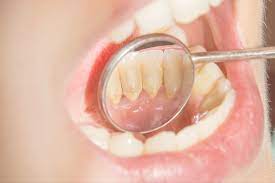For most people, dental calculus is not something we look forward to. But in this case we’re not talking about the subject of math. Dental calculus is actually another name for dental tartar, a hardened deposit of dental plaque found on your teeth and under your gums!
What’s the Equation?
Dental calculus is caused by a buildup of dental plaque, which forms after you eat. The sugars and carbohydrates in food cause the bacteria in your mouth to produce an acid that attacks your teeth. You may not be able to see dental plaque, but you can feel it — it creates a pasty film that not only leaves a bad taste in your mouth, but also causes many dental problems!
Over time, dental plaque that has not been removed by brushing and flossing becomes calcified. Mineral salts are deposited onto teeth, forming a hard, sticky substance that allows even more dental plaque to adhere to it! Think about it this way: If you’ve ever driven through the snow in the winter, you’ve probably seen what the salt on the road can do to your car. And if you don’t wash it off, it can build to the point that it may damage your vehicle. Imagine what happens to your teeth when dental plaque leaves its own salt deposits behind!
The unsightly appearance of dental calculus should give you an idea that something’s wrong with your dental health. If you notice yellow or brown stains on your teeth, it’s most likely from a buildup of dental tartar. Dental calculus is actually a very porous material, which enables it to attract stains easily. And dental calculus will not only contribute to cavities, but it can lead to periodontal disease as well! As dental calculus builds, it starts to creep under your gums and attack the surrounding tissue. The eventual result is gum disease, which can lead to tooth loss if not treated!
Keep It Clean
You may be able to wash the salt off of your car, but you won’t be able to erase dental calculus on your own. Once dental calculus attaches itself to teeth, it can’t be removed with a toothbrush, making a dental visit necessary. Your dentist or dental hygienist has all the tools needed to remove dental calculus. Through a gum disease treatment known as scaling and root planing, dentists are able to dislodge dental calculus — even from under your gum line!
Dentists may use an ultrasonic dental cleaning device to blast away large deposits of dental calculus. Any remaining deposits can be removed using a hand scaler. Once the scaling process is complete, root planing smooths the tooth’s surface, making it harder for dental plaque to reattach itself! This simple procedure can be performed during your dental exam, so be sure to visit a dentist regularly to avoid tooth decay and gum disease.
Brush Twice a Day, But Don’t Keep the Doctor Away!
In order to prevent dental calculus, you have to eliminate its source: dental plaque. Here are some tips to get you started:
Avoid sugary snacks — Healthy eating will minimize the production of dental plaque.
Get a checkup — A dental exam and cleaning will remove dental calculus to better prepare your mouth for an at-home care program. Continue seeing your dentist at least twice a year to keep dental calculus buildup in control.
Practice excellent oral hygiene — Brush at least twice daily, and floss at least once daily. If you can, brush after every meal to keep dental plaque and dental tartar from forming.
Be sure you’re brushing properly — ask a dental professional for oral hygiene tips. And if it’s been awhile since you’ve last seen a dentist, it’s time to make an appointment. The longer you wait to have dental calculus removed, the worse your dental problems can get!

